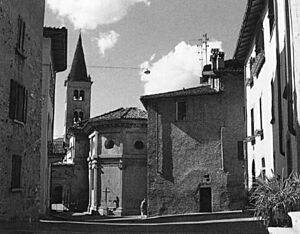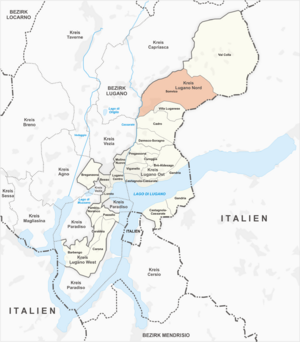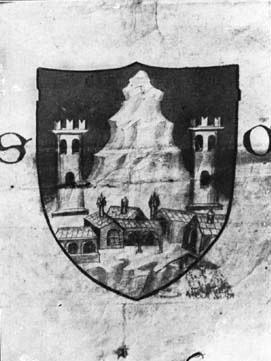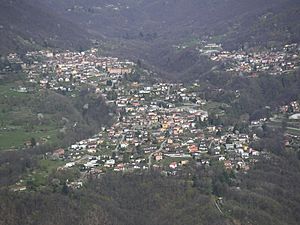Sonvico facts for kids
Quick facts for kids
Sonvico
|
||
|---|---|---|
|
Quarter
|
||
 |
||
|
||
 |
||
| Country | Switzerland | |
| Canton | Ticino | |
| District | Lugano | |
| City | Lugano | |
| Area | ||
| • Total | 11.09 km2 (4.28 sq mi) | |
| Elevation | 603 m (1,978 ft) | |
| Population
(2010-12-31)
|
||
| • Total | 1,837 | |
| • Density | 165.64/km2 (429.02/sq mi) | |
| Postal code |
6968
|
|
| SFOS number | 5224 | |
| ISO 3166 code | CH-TI | |
| Surrounded by | Cadro, Capriasca, Cimadera, Lugano, Valcolla, Valsolda (IT-CO) | |
Sonvico (called Sonvìch in the Lombard language) is a quarter of the city of Lugano in Switzerland. It used to be its own municipality in the Ticino region. On April 14, 2013, Sonvico joined the city of Lugano. It became a new neighborhood within Lugano. The oldest part of Sonvico is like an ancient fortress. It has many narrow and winding streets.
Contents
History of Sonvico
Sonvico was first written about in 1040. Its name, "Summo Vico," comes from Latin. It means "the higher located village."
Early Settlements and Discoveries
People lived in the Sonvico area long ago. We know this from old findings. A grave from the Golasecca culture was found there. Also, a plate with ancient Etruscan writing was discovered. During digs at the San Martino church, Roman and Lombard items were found. These included a woman's grave with a cross brooch from around 650-700 AD. From the 9th to 10th centuries, Sonvico, Dino, and Villa (now part of Lugano) formed a community.
The Castellanza Community
In 1326, Sonvico and its neighbors joined together. They formed a community called The Castellanza. Later, in the 16th century, the village of Cimadera also joined. Sonvico was important because it was high up in the Lugano valley. This valley was a key path to the Alps and the Gotthard Pass.
Sonvico was also well-protected. It had a strong wall and a castle. The castle was built before 1326 and fixed up around the late 1400s. Because of its location and defenses, The Castellanza was a vital base. It served the House of Visconti and the House of Sforza from the Duchy of Milan. This lasted until the Battle of Novara (1513).
Sonvico was so important that it received special rights from the Duchy. It could make many of its own laws. It also did not have to pay certain taxes or customs fees. The first law book, "Libbro degli Statuti della Magnifica Comunità di Sonvico," is from 1473.
During the Italian War of 1499–1504, the Swiss took control of the Ticino region. In 1512, The Castellanza officially became part of the Old Swiss Confederacy. Sonvico resisted for a while. But after signing a deal to keep its old rights, it joined the Swiss. The Swiss agreed, but they demanded the castle be destroyed. The people of Sonvico destroyed their own castle in 1517. Even though the deal promised to keep their rights, not all were respected. The Castellanza felt let down by the Swiss.
Chestnut Farming Economy
The local economy relied on farming. People grew crops, especially chestnuts. They also grew grapes and raised animals. Sonvico was mostly self-sufficient. Over centuries, it developed an economy based on chestnuts. This was common in the area.
The chestnut groves, still visible today, belong to the community. Their use was managed by the old families of Sonvico. This group is now known as the Patriziato (you can find their official page here: official page: http://www.lugano.ch/lugano-politica/quartieri/sonvico/conoscere-il-quartiere/patriziato.html). The chestnut economy lasted until potatoes became popular. People continued to use the chestnut groves even after World War II.
Modern Sonvico History
Because there wasn't much farmland, many people left Sonvico. They looked for jobs elsewhere, often as builders or masons. At first, they moved to nearby European countries. But from the 1800s, many went to the United States and Argentina.
In the early 1900s, some hotels opened in the village. From 1911 to 1979, a train line connected Lugano and Sonvico. During the economic boom of the 1950s and 1960s, new homes were built. Today, Sonvico is mostly a residential area. Its old farmlands have mostly become forests. In 2000, about 80% of workers traveled to jobs in Lugano. Most of them worked in service industries.
The Sonvico community has worked to restore its historic buildings.
- The old wine and walnut press building (Torchio delle Noci) was fixed up in 1983.
- The old community water-mill in the Franscinone Valley was renovated in the 1990s.
- The old administrative building (Casa della Ragione) was renovated in 2012.
- The main Church of San Giovanni Battista in Corcaréi was renovated in 1997-1998.
Geography of Sonvico
Sonvico is located at the northern edge of the Cassarate valley. Before it joined Lugano, its total area was about 11.1 square kilometers. About 12.1% of this land is used for farming. A large part, 80.1%, is covered by forests. About 6.7% of the land has buildings or roads. A small amount, 0.2%, is rivers or lakes. The remaining 3.8% is unproductive land.
The quarter includes the village of Sonvico. It also has a large part called Dino, which has about 600 people. Until 1878, Cimadera village was also part of Sonvico.
Sonvico's Coat of Arms
The blazon (description) of Sonvico's coat of arms is: Gules a saltire argent and in chief tower of the same. This means it has a red background (Gules). On it, there is a silver St. Andrew's cross. At the top, there is a silver tower. The St. Andrew's cross refers to the patron saint of the church.
The Castellanza's old coat of arms had a white unicorn on a blue background. You can still see this in a painting at the entrance of the "Casa della ragione." This building is in the main square, "Piazza Grande." The current coat of arms was given by the Sforza family of Milan in the 15th century.
Population and Demographics
In 2011, Sonvico had a population of 1,852 people. In 2008, about 9.2% of the people living there were foreign nationals. Over ten years (1997–2007), the population grew by 19.5%.
Most people in Sonvico speak Italian (90.1%). German is the second most common language (5.1%). French is the third (2.6%). In 2000, 1,442 people spoke Italian. 82 people spoke German, and 42 spoke French.
The historical population of Sonvico is shown in the chart below:

Important Heritage Sites
The Provost's Church of S. Giovanni Battista a Corcaréi is a very important building. So is the Oratory of S. Martino. Both are listed as Swiss heritage sites of national significance. This means they are important national treasures. The entire village of Sonvico is also listed in the Inventory of Swiss Heritage Sites.
Economy and Work
In 2007, Sonvico had an unemployment rate of 2.86%. In 2005, 15 people worked in the primary economic sector (like farming). There were 6 businesses in this area. 62 people worked in the secondary sector (like manufacturing). There were 16 businesses in this sector. 148 people worked in the tertiary sector (like services). There were 26 businesses in this sector.
In 2000, 187 workers came into Sonvico for work. But 563 workers left Sonvico to work elsewhere. This means more people left Sonvico for work than came in. About 10.7% of workers used public transportation. Most, 67.9%, used a private car to get to work.
Religion in Sonvico
According to the 2000 census, most people in Sonvico are Roman Catholic. About 79.7% (1,275 people) belonged to this church. Another 6.4% (102 people) were part of the Swiss Reformed Church. About 10.63% of the population belonged to other churches. About 3.31% of people did not answer the question about their religion.
Education in Sonvico
In Sonvico, about 78.8% of adults (aged 25–64) have finished higher education. This includes university or other advanced schools.
In 2009, there were 328 students in Sonvico. The Ticino education system offers up to three years of optional kindergarten. In Sonvico, 48 children were in kindergarten. Primary school lasts five years. In Sonvico, 94 students attended regular primary schools.
After primary school, students go to lower secondary school. They can choose a two-year middle school or a four-year program. The four-year program prepares them for higher education. In Sonvico, 86 students were in the two-year middle school. 43 students were in the four-year advanced program.
Upper secondary school prepares students for a trade or university. In Ticino, students can learn a trade while working (3-4 years). Or they can go to school first, then do an internship. In Sonvico, 22 students were full-time vocational students. 23 attended part-time.
There is also a three-year professional program. This prepares students for jobs in fields like engineering or nursing. Nine students were in this program. In 2000, 5 students came to Sonvico from other towns for school. But 132 Sonvico residents went to schools outside the quarter.
See also
 In Spanish: Sonvico para niños
In Spanish: Sonvico para niños







